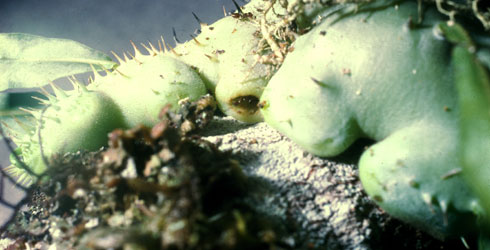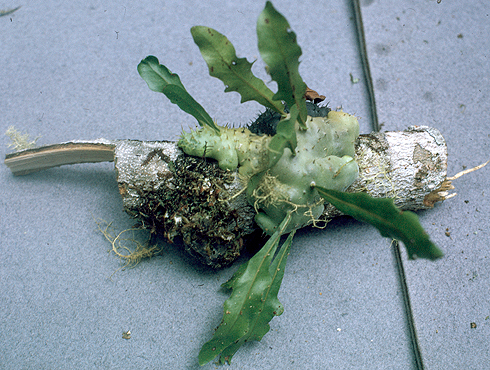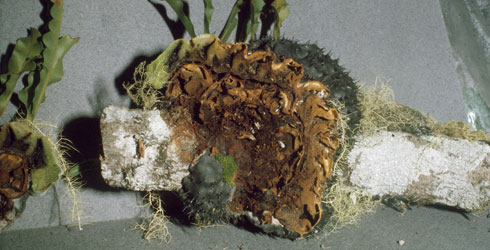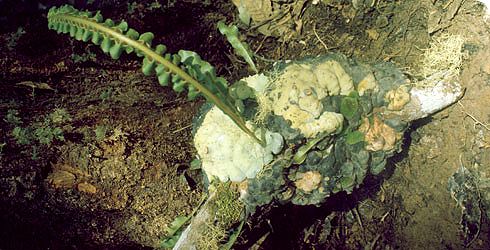Lecanopteris spinosa
Ant-ferns are intriguing plants that have developed a mutually beneficial relationship with ants, whereby:
- ants provide nutrients for the plant
- the plant provides shelter for the ants to live and raise their broods
Lecanopteris spinosa was discovered by Clive Jermy - Head of the Fern Section at the Natural History Museum for many years - and his colleague Trevor Walker from the University of Newcastle-upon-Tyne during an expedition to Sulawesi in 1979. It is still known only from this locality.
The discovery of this species helped to resolve the differences of opinion as to whether to recognise 1 or 2 genera of Old World ant-ferns.
Species detail
Two genera of ferns have a close association with ants - they are myrmecophytic. Both are epiphytes in the Polypodiaceae family:
- Lecanopteris occurs in the Old World tropics and has curious swollen rhizomes that are variously modified to form ‘ant-houses’
- Solanopteris (now regarded as a subgenus of Microgramma) occurs in the New World and develops potato-like tubers on its rhizomes, with hollow chambers in which ants live
In Lecanopteris spinosa the hollow ant-house rhizome grows to form a large spiny ball around the tree branch.
-

Taxonomy
This species has characteristic rhizomes that become hollow as they age, providing an ideal home for ants. Find out more about the appearance of this hospitable plant.
-

Distribution and ecology
Lecanopteris spinosa has been found in only 1 locality in Sulawesi in Indonesia. Discover where this plant and its relatives like to grow.
-

Biology
Find out more about the reproductive strategy of this plant.
-

Ant – fern association
Lecanopteris plants and ants can help each other, but are not completely dependant. Discover how they benefit one another.
-

References
Get reference material for Lecanopteris spinosa and ant – plant associations.
Images

Freshly collected Lecanopteris spinosa plant.
© A C Jermy
Fresh rhizome of Lecanopteris spinosa showing spines.
© A C Jermy
Freshly collected plant of Lecanopteris spinosa.
© A C Jermy
Lecanopteris spinosa in Sulawesi.
© A C Jermy
Lecanopteris spinosa - rhizome of the holotype specimen in the Museum collection.
© P Lund, Natural History Museum, London
Section through a fresh Lecanopteris spinosa rhizome showing hollow chambers with ants removing white pupae.
© A C Jermy
Section through a fresh Lecanopteris spinosa rhizome showing hollow chambers.
© A C Jermy
Holotype of Lecanopteris spinosa mounted on a herbarium sheet in the Museum collection.
© Natural History Museum, London.About the author

Alison Paul
Curator of Pteridophytes, Department of Botany.
A word from the author
"Lecanopteris is a fascinating genus due to its association with ants that live in its rhizomes. This species was discovered in Sulawesi in November 1979 by Clive Jermy - Head of the Fern Section at the Museum for many years - and his colleague Trevor Walker. It is still known only from this 1 locality."
Glossary
Absorption
The process by which water and nutrients are absorbed and conveyed to the plant tissues and organs.
Domatium (plural: domatia)
Part of a plant that has been modified to provide protection for insects, mites or fungi.
Epiphytes
Plants that grow on another plant for support but are not parasitic.
Facultative
Not obligatory - can complete its life cycle independently.
Frond
Fern leaf.
Glaucous
With a waxy blue-green sheen.
Indusium
A structure that covers the sorus.
Monophyletic
Descended from a single common ancestor.
Rachis
A fern's midrib.
Rhizome
A fern's stem.
Sorus
Group of sporangia.
Sporangium
Spore capsule.
